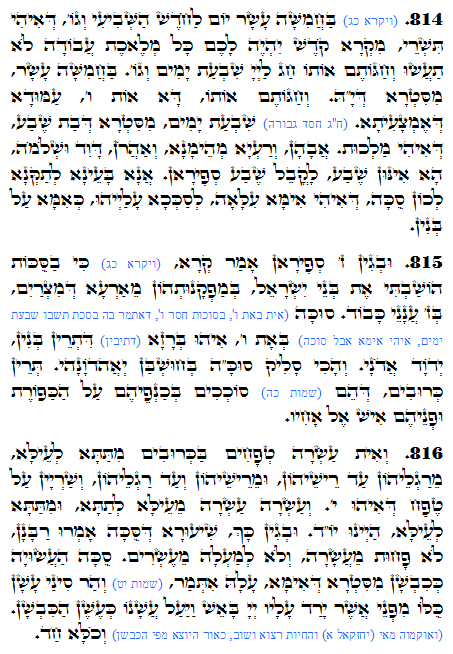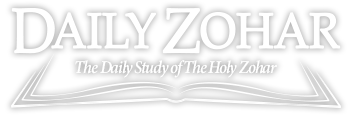Daily Zohar # 1366 – Pinchas – Celebrate a letter
Zohar Pinchas, Vol. 20 (English)/Vol 15 (Hebrew)
Hebrew translation:
814. בַּחֲמִשָּׁה עָשָׂר יוֹם לַחֹדֶשׁ הַשְּׁבִיעִי וְגוֹ’ (ויקרא כג), שֶׁהוּא תִּשְׁרֵי, מִקְרָא קֹדֶשׁ יִהְיֶה לָכֶם. כָּל מְלֶאכֶת עֲבֹדָה לֹא תַעֲשׂוּ. וְחַגֹּתֶם אֹתוֹ חַג לַה’ שִׁבְעַת יָמִים וְגוֹ’. בַּחֲמִשָּׁה עָשָׂר – מִצַּד שֶׁל יָ”הּ. וְחַגֹּתֶם אֹתוֹ – זוֹ אוֹת ו’, הָעַמּוּד הָאֶמְצָעִי. (חַ”ג – חֶסֶד גְּבוּרָה) שִׁבְעַת יָמִים – מִצַּד שֶׁל בַּת שֶׁבַע, שֶׁהִיא מַלְכוּת. הָאָבוֹת, וְהָרוֹעֶה הַנֶּאֱמָן, וְאַהֲרֹן, דָּוִד וּשְׁלֹמֹה – הֲרֵי הֵם שִׁבְעָה, כְּנֶגֶד שֶׁבַע סְפִירוֹת. אֲנִי רוֹצֶה לְתַקֵּן לָכֶם סֻכָּה, שֶׁהִיא אִמָּא עֶלְיוֹנָה, לְסַכֵּךְ עֲלֵיהֶם כְּאִמָּא עַל בָּנִים.
815. וּמִשּׁוּם שֶׁבַע סְפִירוֹת אָמַר הַפָּסוּק, (ויקרא כג) כִּי בַסֻּכּוֹת הוֹשַׁבְתִּי אֶת בְּנֵי יִשְׂרָאֵל, בְּצֵאתָם מֵאֶרֶץ מִצְרַיִם, בְּשִׁבְעָה עַנְנֵי כָבוֹד. סֻכָּה (יֵשׁ שֶׁכְּתוּבָה בְּאוֹת ו’, בַּסֻּכֹּת חָסֵר ו’, שֶׁנֶּאֱמַר בָּהּ בַּסֻּכֹּת תֵּשְׁבוּ שִׁבְעַת יָמִים. הִיא אִמָּא. אֲבָל סֻכָּה) בְּאוֹת ו’ הִיא בְּסוֹד (הַתֵּבוֹת) שֶׁל שְׁנֵי בָנִים – יְהֹוָה אֲדֹנָי. וְכָךְ עוֹלָה סוּכָּ”ה בְּחֶשְׁבּוֹן יְאֲהדֹוָנָהי. שְׁנֵי כְרוּבִים, שֶׁהֵם (שמות כה) סֹכֲכִים בְּכַנְפֵיהֶם עַל הַכַּפֹּרֶת וּפְנֵיהֶם אִישׁ אֶל אָחִיו.
816. וְיֵשׁ עֲשָׂרָה טְפָחִים בַּכְּרוּבִים מִמַּטָּה לְמַעְלָה, מֵרַגְלֵיהֶם עַד רָאשֵׁיהֶם, וּמֵרָאשֵׁיהֶם עַד רַגְלֵיהֶם, וְשׁוֹרִים עַל טֶפַח שֶׁהוּא י’. וַעֲשָׂרָה עֲשָׂרָה מִמַּעְלָה לְמַטָּה, וּמִמַּטָּה לְמַעְלָה, כְּלוֹמַר יוֹ”ד. וּמִשּׁוּם זֶה שִׁעוּר סֻכָּה אָמְרוּ חֲכָמִים, לֹא פָחוֹת מֵעֲשָׂרָה, וְלֹא לְמַעְלָה מֵעֶשְׂרִים. סֻכָּה הָעֲשׂוּיָה כְּכִבְשָׁן מִצַּד שֶׁל אִמָּא, עָלֶיהָ נֶאֱמַר (שמות יט) וְהַר סִינַי עָשַׁן כֻּלּוֹ מִפְּנֵי אֲשֶׁר יָרַד עָלָיו ה’ בָּאֵשׁ וַיַּעַל עֲשָׁנוֹ כְּעֶשֶׁן הַכִּבְשָׁן. (וּפֵרְשׁוּהוּ, מַהוּ (יחזקאל א) וְהַחַיּוֹת רָצוֹא וָשׁוֹב? כְּאוּר הַיּוֹצֵא מִפִּי הַכִּבְשָׁן) וְהַכֹּל אֶחָד.
Pinchas 814-816
Leviticus 23:39
“אַךְ בַּחֲמִשָּׁה עָשָׂר יוֹם לַחֹדֶשׁ הַשְּׁבִיעִי, בְּאָסְפְּכֶם אֶת-תְּבוּאַת הָאָרֶץ, תָּחֹגּוּ אֶת-חַג-יְהוָה, שִׁבְעַת יָמִים; בַּיּוֹם הָרִאשׁוֹן שַׁבָּתוֹן, וּבַיּוֹם הַשְּׁמִינִי שַׁבָּתוֹן”
” “On the fifteenth day of the seventh month, when you have gathered in the produce of the land, you shall celebrate the feast of YHVH seven days. On the first day shall be a solemn rest, and on the eighth day shall be a solemn rest.”
Leviticus 23:41
” וְחַגֹּתֶם אֹתוֹ חַג לַיהוָה, שִׁבְעַת יָמִים בַּשָּׁנָה: חֻקַּת עוֹלָם לְדֹרֹתֵיכֶם, בַּחֹדֶשׁ הַשְּׁבִיעִי תָּחֹגּוּ אֹתוֹ”
” You shall celebrate it as a feast to the LORD for seven days in the year. It is a statute forever throughout your generations; you shall celebrate it in the seventh month.”
The fifteenth of the seventh month is the Holiday of Sukkoth and it’s a seven days celebration.
‘וְחַגֹּתֶם אֹתו’ ‘ You shall celebrate it’, The Zohar reveals that ‘it’ ‘ אֹתו’ is את and ו, which means celebrate the ו Vav, that is Zeir Anpin. On Sukkoth we connect to Zeir Anpin through the use of the Sukkah, the Lulav and the Ushpizin.
The Sukkah is simple construction of four walls and a ‘roof’ that is made out of natural branches of tree or similar. It has six direction for the six Sefirot of Zeir Anpin. We are instructed to dwell in the Sukkah for seven days because inside it we become the aspect of Malchut and able to connect and draw the light that comes from the six Sefirot of Zeir Anpin.
The Lulav is a branch of Palm tree bonded together with three myrtle branches and two willow branches. The six elements is the aspect of Zeir Anpin on a physical level. The seventh element is the Etrog, which is a citrus fruit and the aspect of Malchut. we use the Lulav and Etrog during the the prayer of the Halel. The Halel connects us to the Sefirot of Zeir Anpin and with the Lulav and the Etrog we maximize in drawing the light that is available for us during the seven days.
The Ushpizin are special ‘guests’ that we invite during a meal that we do in the Sukkah. They are the chariots of the Seven Sefirot and on each day we invite a different one corresponding the the Sefira of that day. The first days is Chessed and we invite Abraham, then Isaac for Gevurah, Jacob for Tiferet, Moses for Netzach, Aaron for Hod, Joseph for Yessod and David for Malchut.
The word for Sukkah סוכה has the numerical value of 91 and represent the unification of the upper name יהוה YHVH with the lower name אדני ADNY as יאהדונהי.
Exodus 25:20
” וְהָיוּ הַכְּרֻבִים פֹּרְשֵׂי כְנָפַיִם לְמַעְלָה, סֹכְכִים בְּכַנְפֵיהֶם עַל-הַכַּפֹּרֶת, וּפְנֵיהֶם, אִישׁ אֶל-אָחִיו; אֶל-הַכַּפֹּרֶת–יִהְיוּ, פְּנֵי הַכְּרֻבִים ”
” The cherubim shall spread out their wings above סֹכְכִים, overshadowing the mercy seat with their wings, their faces one to another; toward the mercy seat shall the faces of the cherubim be.”
The word used to describe the action of the cherubim over the Ark is the same as the word used for the cover of the Sukkah, סככ (100) and ים that is numerically 50 is for Binah. Rabbi Ashlag reveals that the Cherubim are the secret of Zeir Anpin and Malchut.
The entire process and tools is for us to manifest in our lives and for the coming year the light of Binah that we drew few days earlier on Yom Kippur.
It is important to know that studying the deep secrets and the spiritual aspects of the holidays as well as every precept in the Torah is a way to connect to the root energy of the events or the precepts. The root of our souls is in the Torah and the secret revealed by the Zohar shines that light in our soul, correct it and cleanse it.
That aspect is what makes the study of the Zohar so valuable to our souls. Even if we miss on some precepts or holidays we can fill the gap with the study of the Zohar.
{||}

 Previous: Pinchas
Previous: Pinchas

